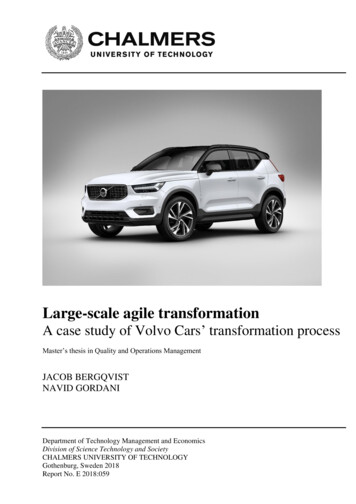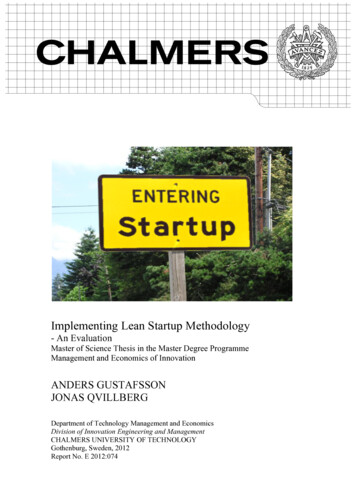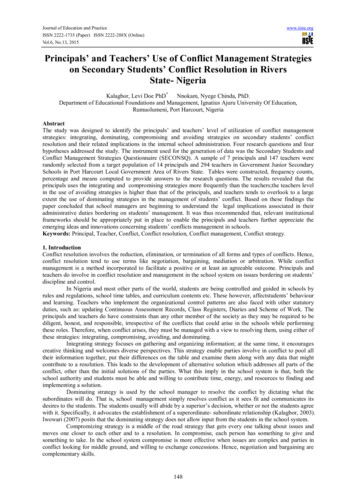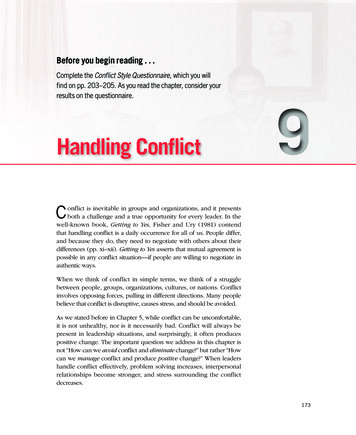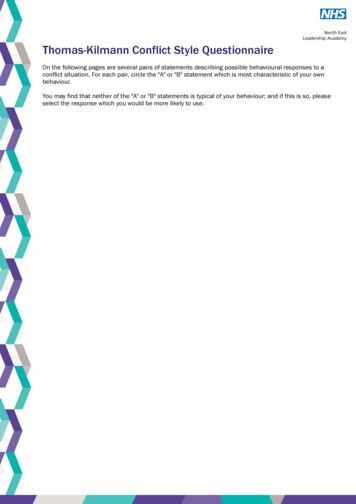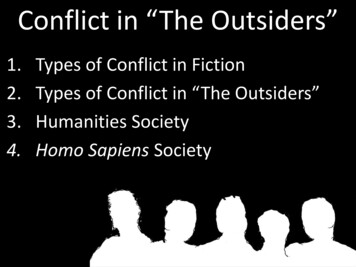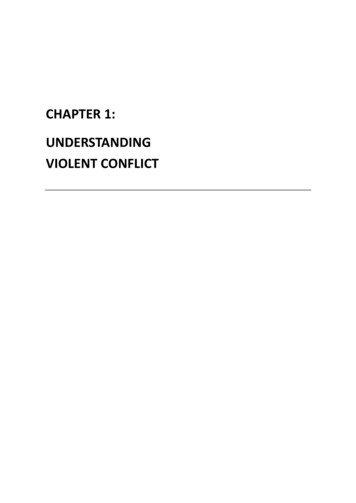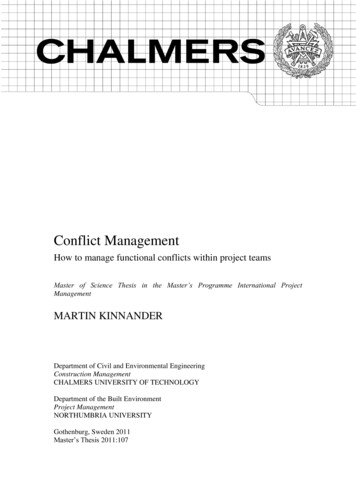
Transcription
Conflict ManagementHow to manage functional conflicts within project teamsMaster of Science Thesis in the Master’s Programme International ProjectManagementMARTIN KINNANDERDepartment of Civil and Environmental EngineeringConstruction ManagementCHALMERS UNIVERSITY OF TECHNOLOGYDepartment of the Built EnvironmentProject ManagementNORTHUMBRIA UNIVERSITYGothenburg, Sweden 2011Master‟s Thesis 2011:107
MASTER‟S THESIS 2011:107CONFLICT MANAGEMENTHow to manage functional conflicts within project teamsMartin KinnanderCHALMERS UNIVERSITY OF TECHNOLOGYDEPARTMENT OF CIVIL AND ENVIRONMENTAL ENGINEERINGUNIVERSITY OF NORTHUMBRIA AT NEWCASTLESCHOOL OF THE BUILT AND NATURAL ENVIRONMENT
CONFLICT MANAGEMENTHow to manage functional conflicts within project teamsMaster of Science Thesis in the Master’s Programme International ProjectManagement MARTIN KINNANDER, 2011Department of Civil and Environmental EngineeringConstruction ManagementChalmers University of TechnologySE-412 96 GothenburgSwedenTel: 46 (0)31-772 1000Department of the Built EnvironmentProject ManagementNORTHUMBRIA UNIVERSITYNewcastle City CampusEllison PlaceNewcastle upon Tyne, NE1 8STUKTelephone: 44 (0)191 232 6002
ACKNOWLEDGEMENTSI would like to thank my supervisor Dr. Max Rapp Ricciardi for his guidance andfor many interesting lectures during my time at Chalmers University of Technology.I would also like to thank Dr. Allan Osborne because he led me into a sufficientlynarrow range that made this study fair and workable.Many thanks also to those whom I had the opportunity to interview and for theircommitment and sharing of experiences that enriched this study.
ABSTRACTThe role as a project manager comes with dealing with all kinds of conflicts with differentlevel of emotional involvement. Since so much time is spent on resolving these issues, beingable to resolve conflict efficient becomes essential for the project manager. Time, cost andquality are three major measures of value for a project, if conflicts can be managedprofessionally and effectively during the project process it will have a positive effect on thesemeasures of value.How one approach a conflict is very individual, conflicts where emotions play a big role arethe ones that really can threaten the project and the relationships between project teammembers.This thesis focuses on investigating different kinds of approaches and methods when dealingwith conflicts. One area that has been highlighted is methods that can prevent conflicts anddevelop the behaviours of team members. Through methods like feedback, each individual candevelop and get a chance to get to know themselves and their behaviours.The project manager should ensure that emotional charged issues don’t evolve to a conflictwhich could develop and become dysfunctional. In order to resolve a conflict a conflictcompetent project manager should be able to see the conflict from an independent perspectiveThrough this study it has been revealed that conflict management can be divided into twoareas, prevention of conflicts and management of functional conflicts.Keywords:Conflict, Management, Project, Team
TABLE OF Background21.4Limitations3THEORETICAL FRAMEWORK2.131Conflict Forms442.2Approaches2.2.1Team Configurations2.2.2Task Interdependence2.2.3Self-efficacy2.2.4Conflict Culture5899102.3Conflict Escalation2.3.1The Dynamic Conflict Model2.3.2Hot buttons2.3.3The retaliatory cycle2.3.4Intensity levels11111212132.4Conflict Resolution2.4.1Organizational Justice2.4.2The Role of Emotions2.4.3Conflict Dynamics Profile2.4.4Perspective Taking2.4.5Logical Argument Mapping (LAM)2.4.6Vaaland‟s improvement model2.4.7Active Conflict mary26METHODOLOGY273.1Type of Dissertation273.2Type of Research273.3Research procedure283.4Methods3.4.1Literature Review3.4.2Interviews2828283.5Data Sources293.6Reliability29
43.7Limitations303.8How is the data organized and ealing with conflict4.1.2Triggers4.1.3Decision making processes4.1.4Feedback4.1.5Logical Argument Mapping (LAM)4.1.6Openness at the workplace4.1.7Negotiation4.1.8Conflict management CONCLUSION476.1Further research48REFERENCES49APPENDICESAppendix A - Interview Questions5252
TABLE OF FIGURESFigure 1, Dynamic Conflict Model (Runde and Flanagan, 2007)11Figure 2, The Retaliatory Cycle (Runde and Flanagan, 2007)12Figure 3, Conflict Intensity levels (Runde and Flanagan, 2007)13Figure 4, Collateral knowledge (Hoffmann, 2005, p.313)19Figure 5, Key stages of the negotiation analysis approach, Murtoaro et al. (2007)25Figure 6, Methodology Structure27
1Introduction1.1PurposeThe purpose with this thesis is to compare and link theoretical models and hypotheseswith qualitative research that together will build up a strategic proposal for how toapproach and manage a conflict before it develops into a dysfunctional issue. Thereason why conflict management should be investigated further and developed foreffective usage is because the people within the project are the ones that make itpossible to reach the objectives; they are the key to project success. Thereforeknowing how to successfully unite the team towards a common objective is one of themost essential skills for a project manager to hold. Further the study aims to be part ofthe author‟s own growth within the project management area when it comes toleadership, communicative skills and the ability to foresee and manage conflicts.Finally this thesis aims to contribute with further knowledge of how to effectivelymanage functional conflicts and to inspire others to do supplementary research andcase studies within this area.Research questions:1) What triggers conflict and how does conflicts evolve?2) Explore different conflict management approaches.3) Identify and evaluate different tools and behaviours for how to manage andresolve conflicts within project teams.CHALMERS, Civil and Environmental Engineering, Master Thesis 2011:1071
1.2ObjectivesThe objective with the research made in this dissertation is to explore the conflictmanagement area further. Many project managers in different organisations arespending a lot of time on managing conflicts, time that could have been spent onadding value to the company. Developing an approach to conflicts that makes thesolving process more efficient gives the project manager and the project team a biggerpossibility to meet the project requirements. This report will also benefit the author inthe means of new knowledge within conflict management, both on a professionallevel and in ordinary life.1.3BackgroundA project team is often defined as „two or more people with some shared purpose whoassume different responsibilities, depend on each other, coordinate their activities, andsee themselves as part of the group‟ according to Boddy (2002, p.108). Project teamstend to include individuals with different background which means that moreknowledge from various fields can be added to the project. Furthermore it inevitablycomes with the team members having different perspectives on tasks leading topossible conflicts. According to Boddy (2002, p. 110) organisations can see theseconflicts as an opportunity for renewal and productivity if it could be managed andkept within certain boundaries. Boddy (2002, p. 114) explains a high-performanceteam as a team where „members are deeply committed to one another‟s personalgrowth and to a common purpose‟. During the forming and development of a teamBoddy (2002, p.136) brings forward a team development theory by Tuckman andJensen (1977) where a team passes through five phases where the storming phase areseen as the most critical stage. It is explained that the differences in values and normsbetween the team members becomes more apparent and forces the team to deal withthe differences and issues within the team. Successful conflict management andunderstanding becomes in the storming phase crucial for the survival of the team anda key for reaching the performing phase where the team delivers the objectivesefficiently.CHALMERS, Civil and Environmental Engineering, Master Thesis 2011:1072
Hughes, Ginnett and Curphy (2009) highlights that research has shown that middlelevel managers spend 25 % of their time resolving conflicts. Knowledge of conflictmanagement should therefore be one of the manager‟s strongest characteristics.Increased understanding of how conflicts arise and what they depend on cancontribute to conflict resolution in a more efficient manner. This can lead to moretime spent on bringing the projects forward, time is money. Except the negativeeffects of conflict like reduced productivity, stress and decreased cooperation Hughes,Ginnett and Curphy (2009) claims that from a conflict, positive effects could arise aswell. Positive effects worth pointing out are that feelings get aired, enhancedunderstanding of others, improved decision making and stimulation of criticalthinking.1.4LimitationsThis research will focus on conflict management within organisational boundaries andproject teams. Further it will investigate conflicts that are functional and how toresolve a conflict before it becomes dysfunctional.Differences between branches and organisations will not be a part of this research andorganizational culture's impact on conflict management will not to be taken intoconsideration; instead the research will be done from a general perspective.Moreover the research will focus on project teams where most work and collaborationis done face to face and not virtually.Cultural factors such as different national cultures, values and religious beliefs as asource of possible disagreements/conflicts within multi cultural project teams will notbe investigated in this research. Instead of focusing on the sources for conflicts theresearch will investigate different approaches to conflicts and how to managefunctional conflicts efficiently.CHALMERS, Civil and Environmental Engineering, Master Thesis 2011:1073
2 Theoretical Framework2.1Conflict FormsKurtzberg et al. (2005) brings forward that research has proved that there are threemain types of conflicts. Conflicts based on the work process, how work is performedand obligation of team roles and responsibilities. The second form of conflict is therelationship-based conflict, where relationships and interaction between teammembers are the source. Finally the third form is the task-based conflict wheredisagreements about the work task itself causes the issue. Kurtzberg et al. (2005)claims that there is a linear correlation between team performance and task-basedconflicts, research has pointed out that in some cases task-based conflicts can actuallybe beneficial. Moreover Kurtzberg et al. (2005) expresses that process-based andrelationship-based conflicts only can have negative effects on team performance. Thepositive contribution through task-based conflicts is according to Kurtzberg et al.(2005) the promotion and unveiling of different perspectives which could stimulateinnovation and creative thinking. The possible negative effects of a conflict are thusalways a threat, according to Kurtzberg et al. (2005) psychological affects and teammember relationships are at all times very vulnerable. Kurtzberg et al. (2005) arguesthat „it is tremendously difficult for individuals to remain objective about a situationwhen they feel that others are disagreeing, or even disapproving, of their point ofview‟.Ohbuchi et al. (2003) has a different perspective on conflicts and brings forward adifferent categorization. The first conflict form is called “conflict of interest” andconcerns issues between people and their interests. “Cognitive conflict” is the secondform which arises through people having different views on things. The third and lastform is called “value conflict” and occurs through disagreements concerning differentvalues or expectations. Conflict issues brought forward by Ohbuchi et al. (2003) thatcan be linked to these three main categories are:Gain/loss issues – „We discussed my promotion!‟Correct/incorrect issues – „I was criticized for my work performance!‟Right/Wrong issues – „I asserted that the other person violated a rule!‟CHALMERS, Civil and Environmental Engineering, Master Thesis 2011:1074
Ohbuchi et al. (2003) claims that research points out that gain/loss issues encourages“conflict of interest” while correct/incorrect issues demands collaboration andright/wrong issues encourages participants to confront the problem.2.2ApproachesConflict Management patterns are often according to Desivilya et al. (2005) related toa dual concern model divided into concern for self and concern for others. Furtherdifferent conflict management approaches are based on these two motives, somefocusing more on concern for self or concern for others.From these motives Desivilya et al. (2005) brings forward five main conflictmanagement patterns:Dominating - „High concern for self and low concern for the other‟Obliging - „Low concern for self and high concern for the other‟Avoiding - „Low concern for self and low concern for the other‟Integrating - „High concern for self and high concern for the other‟Compromising - „Moderate concern for self and moderate concern for the other‟(Desivilya et al. 2005)Moreover Desivilya et al. (2005) stresses that project team members more oftenchoose to use a passive approach. To passive strategies counts obliging and avoidingwhile integrating, compromising and dominating belongs is seen as an active strategy.In comparison with Desivilya et al. (2005) Hughes, Ginnett and Curphy (2009) havechosen to look at conflict management approaches from a slightly differentperspective. They claim that conflict resolution can be divided into two independentdimensions, cooperativeness/uncooperativeness and assertiveness/unassertiveness.From
reason why conflict management should be investigated further and developed for effective usage is because the people within the project are the ones that make it possible to reach the objectives; they are the key to project success. Therefore knowing how to successfully unite the team towards a common objective is one of the most essential skills for a project manager to hold. Further the .
